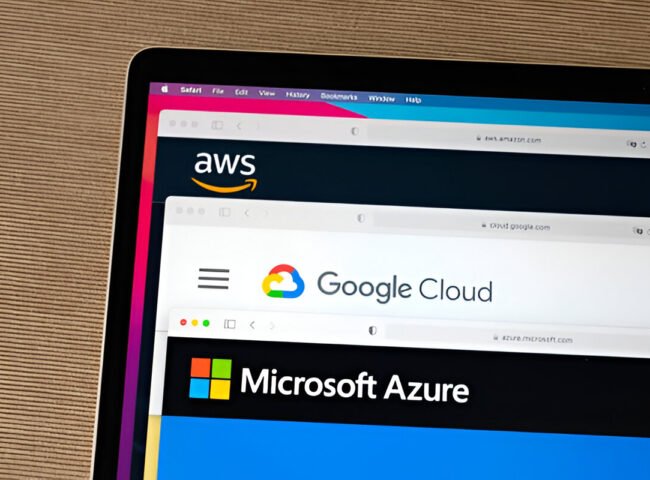To get free Amazon Web Services (AWS), sign up for the AWS Free Tier. This program offers free amounts of several AWS services for 12 months following your initial sign-up date.
Amazon Web Services (AWS) provides a comprehensive cloud platform used by millions, from startups to large corporations and government agencies. To cater to new users, AWS introduced the Free Tier, a program designed to help you get started with a range of services at no cost.
This Free Tier allows you to explore and test AWS solutions, understanding the platform’s potential without immediate investment. You’ll find certain limitations on usage—it’s aimed at giving you a taste of AWS capabilities. Whether you’re learning cloud concepts, building your first applications, or testing out different services, the AWS Free Tier is an invaluable resource. It bridges the gap between theory and practice, enabling users to apply their skills in a real-world environment. Remember to monitor your usage to avoid charges once you reach the limits of the free offerings.
Introduction To Aws And Cost Efficiency
Why Cost Saving Is Crucial In Cloud Computing
Efficiency in cloud computing equals lower expenses and higher margins. Firms seek to maximize their investments in the cloud. Prudent spending ensures long-term sustainability and innovation.- Reduced Operational Costs: Less spending on physical infrastructure.
- Scalability: Pay for what you use, avoiding wasted resources.
- Budget Flexibility: Direct funds to other growth areas.
The Reach And Impact Of Amazon Web Services
AWS powers millions of businesses globally. Its tools and services foster growth, agility, and resilience.| AWS Service | Use Case | Cost Efficiency Feature |
|---|---|---|
| EC2 | Virtual Servers | Auto Scaling |
| S3 | Storage Solutions | Infrequent Access Pricing |
| RDS | Database Management | Reserved Instances |
Spotting Free Services In Aws
Navigating The Aws Free Tier
AWS Free Tier serves as the gateway to explore services without spending a dime. Here’s how users can maximize its benefits:- Sign up for an AWS account to start your free tier journey.
- Review the 12-month Free Tier details. This is valid for new users.
- Understand that some services are time-bound. Others offer a certain amount of resources monthly.
- Check regularly on your usage to ensure you stay within Free Tier limits.
Identifying Permanently Free Services
Not all services revert to a paid model after the initial trial. Here’s a rundown of permanently free services:| Service | Free Offer | Use Case |
|---|---|---|
| AWS Lambda | 1M requests per month | Run code in response to events. |
| Amazon DynamoDB | 25GB of storage | Manage NoSQL database services. |
| AWS CodeCommit | Unlimited private repositories | Host secure Git-based repositories. |
Maximizing Aws Free Tier Benefits
Tips For Avoiding Charges After Trial Periods
- Monitor Usage: Keep an eye on service dashboards regularly to control usage.
- Set Alarms: Use AWS CloudWatch to set billing alerts and stay within limits.
- Clean Up: Ensure you delete unused resources to prevent accruing fees.
- Understand Policies: Read the AWS Free Tier terms to know expiration dates and limits.
- Use Budgets: Create and adhere to AWS Budgets to manage costs effectively.
Making The Most Of Aws Free Services
Amazon Web Services offers an extensive range of free services within its Free Tier. Smart utilization of these services can provide a robust cloud experience without expenditure. Let’s dive into strategies to make the most of what AWS offers without cost.- Choose ‘Always Free’ Offers: Some services are always free, not just for 12 months.
- Experiment Wisely: Use the free tier to test and develop applications efficiently.
- Scale with Care: Start small and only scale when necessary to stay within limits.
- Leverage Free Training: AWS provides free educational resources to enhance skills.
Understanding Aws Pricing Models
Comparing On-demand Vs Reserved Instances
Picking the right type of instances for your AWS services is key for cost efficiency.| On-Demand Instances | Reserved Instances |
|---|---|
| Pay for compute capacity per hour or second with no commitment. | Commit to a one or three-year term and get a significant discount. |
| Ideal for short-term, irregular workloads that cannot be interrupted. | Best for applications with steady state or predictable usage. |
| No upfront payment needed. | Pay upfront for the entire term to maximize savings. |
Decoding The Aws Pricing Calculator
The AWS Pricing Calculator simplifies budget predictions. It helps users estimate costs for AWS services.- Select your service.
- Input configurations and usage estimates.
- Review the detailed cost report.
Aws Budgets And Cost Management Tools
Setting Up And Managing Aws Budgets
Control your AWS costs through AWS Budgets. Begin by specifying the amount you want to spend. Then, AWS watches that amount for you. Get alerts if spending is set to go over. This helps to stay within your budget. Here’s how you do it:- Open the AWS Budgets dashboard.
- Click ‘Create a budget’.
- Choose budget type: cost or usage.
- Set budget amount and period.
- Define alerts based on thresholds.
- Confirm and create your budget.
Monitoring With Aws Cost Explorer
AWS Cost Explorer lets you examine your spending patterns. Use its visual tools to understand your costs. This is perfect for spotting trends. Unlock these features:- View detailed reports of your spending.
- Breakdown costs by service, region, or linked account.
- Forecast future spending using historical data.
- Use filters to refine your view.
Cost Optimization Best Practices
Rightsizing Instances For Savings
Rightsizing means picking the suitable instance size for your needs. Too often, services run on instances larger than necessary. This leads to wasted expenditures. It involves evaluating your computing services. It ensures they are operating on the most cost-efficient AWS resource types and sizes. Below are steps to get started:- Monitor Performance: Use AWS CloudWatch to track how instances use resources.
- Analyze the Data: Look for patterns in CPU, memory, and network usage.
- Select the Right Size: Pick an instance size that matches your actual usage.
- Continuous Review: Regularly check to adjust as your requirements change.
Using Auto Scaling To Adjust Resources
Auto Scaling optimizes costs and performance. By automatically adjusting the number of resources in response to demand, you avoid over-provisioning. Here’s how to set up Auto Scaling:- Define Scaling Policies: Decide when to scale out (add resources) and scale in (remove resources).
- Implement Scaling Triggers: Base these on metrics like CPU utilization or network input/output.
- Test Your Setup: Make sure your Auto Scaling works by simulating changes in demand.
Leveraging Aws Cost And Usage Reports
Analyzing Reports For Better Cost Management
Analyzing AWS Cost and Usage Reports shines a light on your spending. It uncovers trends and patterns.- Identify High Costs: Spot services that consume the most funds.
- Track Changes Over Time: See how changes affect your bill.
- Optimize Spending: Adjust usage to fit budget goals.
Customizing Reports To Your Needs
Customizing reports gives you control. Target the information you need most.- Set Date Ranges: Focus on specific time periods.
- Group by Service: Organize costs by AWS services.
- Use Tags: Filter by project or team labels.
Taking Advantage Of Aws Credits
How To Qualify For Aws Promotional Credits
Getting AWS credits isn’t magic. It’s about knowing where to look and what to do. Follow these clear steps:- Join the AWS Activate Program if you’re a startup. It’s tailor-made for you!
- Attend AWS Training and Certification events. Credits often come as perks.
- Engage in AWS Community programs. Participation can bring rewards.
- Work on an open-source project. AWS is known to support open-source initiatives.
Effective Utilization Of Credits
Once you have AWS credits, using them wisely is crucial. Let’s make every credit count:- Before experimenting, plan your AWS usage. Know what services fit your goals.
- Keep track of credits with AWS Budgets. Never lose sight of your spending.
- Use the credits for testing new services. Expand your cloud capabilities.
- Apply credits to high-cost services first. This tactic maximizes your savings.
- Distribute credits across the team if applicable. Maximize their collective benefit.
Case Studies: Success Stories Of Free Aws
Startups Thriving With Aws Free Tier
Young businesses often face budget constraints. AWS Free Tier becomes a lifeline for them. It allows access to potent tools without hefty price tags. Let’s explore how startups climb the success ladder using AWS.- Startup ABC: Leveraged AWS to manage data. Improved customer service. Gained actionable insights. Boosted sales by 20%.
- Startup XYZ: Used AWS for website hosting. Achieved 99.9% uptime. Enhanced user experience. Doubled their online traffic.
Larger Enterprises Cutting Costs On Aws
It’s not just startups that benefit from AWS Free Tier. Large companies reduce costs. They streamline operations while using AWS services. Let’s look at some examples.| Company | Service Used | Impact |
|---|---|---|
| Enterprise A | Amazon EC2 | Saved 30% on infrastructure costs |
| Enterprise B | AWS Lambda | Reduced code deployment time by 50% |
Aws Support Plans And Cost Savings
Choosing The Right Support Plan
Picking the correct AWS Support Plan is crucial for balancing cost against the need for technical support and resources. AWS offers various plans:- Basic: Ideal for experimentation, offers customer service, documentation.
- Developer: Suited for development stages, includes email support.
- Business: Offers 24/7 support, infrastructure event management for operational businesses.
- Enterprise: Designed for mission-critical workloads, provides a Technical Account Manager and the highest response times.
Free Support Resources Available In Aws
Access a wealth of knowledge without spending extra. AWS offers numerous free resources:| Resource | Description |
|---|---|
| Documentation | Comprehensive guides and tutorials to self-serve troubleshooting. |
| Forums | Engage with a community of users and AWS experts for advice and tips. |
| Whitepapers | Explore best practices and optimization strategies. |
| Training | Free digital training to improve cloud skills. |
Considering Aws Marketplace For Free Solutions
Discovering Free And Trial Software Products
With AWS Marketplace, access an assortment of free and trial software products. Whether starting out or testing new solutions, here’s how to benefit:- Sort by Price: Quickly filter searches to showcase items at no cost.
- Check for Trials: Many providers offer limited-time trials for their services.
- Read Reviews: Gain insights from existing users before trying.
How To Securely Try Third-party Services On Aws Marketplace
Security remains paramount while trying third-party services. Here’s a simple guide to ensure safe trials:- Create a Private Sandbox: Isolate the trial software within a secure environment.
- Use IAM Roles: Control access with AWS Identity and Access Management roles.
- Monitor Activity: AWS CloudTrail records account activity for visibility and auditability.
Security Considerations In The Free Tier Usage
Ensuring Security While Using Aws Free Services
To keep your data safe on AWS, start by understanding the Shared Responsibility Model. AWS secures the infrastructure, while users must protect their data. Follow these steps for a robust security posture:- Activate Multi-Factor Authentication (MFA) on all accounts to add an extra security layer.
- Use Identity and Access Management (IAM) to control user permissions rigorously.
- Regularly review and update access rights.
- Monitor usage with AWS CloudTrail to detect unusual activities early.
Common Pitfalls To Avoid In Aws Security Management
Missteps can compromise security. Be aware of these common pitfalls:| Security Pitfall | Risks | Prevention Tip |
|---|---|---|
| Default Settings | May not meet specific security needs | Customize settings to fit usage patterns |
| Poor Password Policies | Weak passwords can be easily breached | Enforce strong password requirements |
| Lack of Regular Audits | Unnoticed security gaps | Conduct frequent security assessments |
Leveraging Aws Educate For Learning And Cost Savings
Aws Educate Program Perks For Students And Educators
- No cost: Sign up for free and explore cloud technology.
- Credit: Get promotional AWS credit. Build without spending.
- Training: Access to courses and labs. Learn at your pace.
- Job board: Connect with employers. Kickstart your career in cloud computing.
Building Skills In Aws Without Breaking The Bank
Save money: Utilize AWS Educate’s credits to learn without fees. Dive into AWS services without financial fears. Expand knowledge: Tackle beginner to advanced topics. Stay ahead in the cloud arena. Gain experience: Hands-on labs translate theory into practical skill. Improve your mastery in AWS.Preparing For Scale: Free Now, What About Later?
Planning For Growth While On Aws Free Tier
The AWS Free Tier provides an array of benefits, yet it’s designed for testing and small-scale operations. To ensure a smooth transition to larger-scale services, plan for growth:- Create scalable architectures from the start.
- Monitor usage and set alerts for limits.
- Estimate future costs with the AWS Pricing Calculator.
- Optimize resources to avoid unnecessary costs.
Transition Strategies When Scaling Up
As your business grows, your AWS usage will too. It’s essential to have a seamless transition strategy. Here’s how:| Strategy | Description | Benefits |
|---|---|---|
| Gradual Scaling | Slowly increase resources as needed. | Better cost management, reduced risks. |
| AWS Auto Scaling | Automatically adjust resources. | Responds to demand, prevents downtime. |
| Reserve Instances | Purchase services with long-term commitments for discounts. | Cost savings for steady-state usage. |
Optimizing Data Storage On Aws To Slash Costs
- Amazon S3 for web-based storage.
- EBS for block-level storage.
- EFS for file storage across AWS services.
- Glacier for long-term archival.
| Service | Type | Use Case | Cost Effective For |
|---|---|---|---|
| S3 | Object Storage | Web-based | Active Usage |
| EBS | Block Storage | EC2 Instances | I/O Intensive |
| EFS | File Storage | Shared Access | Multiple Services |
| Glacier | Archival | Long-Term Backup | Rare Access |
- Create a lifecycle policy in the S3 console.
- Choose when to move data to another storage class.
- Set deletion rules for obsolete files.
Aws Compute Savings Plans
Understanding Compute Savings Plans
Compute Savings Plans are a commitment-based billing option. These plans give you low prices on EC2, Fargate, and Lambda compute in exchange for a commitment to a consistent amount of usage, measured in $/hour, for a 1 or 3-year term. This usage is applied across any AWS region, making it versatile for businesses operating on a global scale. This flexibility allows you to adapt to changes in your computing needs without sacrificing savings.- Choose commitment term: 1 or 3 years to match your business plan.
- Enjoy flexible usage: Savings apply to any instance family, region, and operating system.
- You can switch families, OS, or tenancy throughout the plan.
Comparing Savings Plans To Traditional Reserved Instances
Savings Plans and Reserved Instances (RIs) both provide ways to save. Yet, they differ in how they offer flexibility and savings.| Feature | Compute Savings Plans | Reserved Instances |
|---|---|---|
| Versatility | Apply to any instance regardless of family, OS, or AWS region. | Limited to specific instance types and regions. |
| Payment Options | Flexible payment terms with partial upfront or no upfront costs. | Requires upfront payment for the best savings. |
| Commitment Term | 1 or 3-year terms with the ability to adjust to changing needs. | 1 or 3-year commitment with less flexibility. |
| Exchange and Modification | Easy to modify or exchange based on current computing needs. | Possible but with more restrictions and potential fees. |
Harnessing Aws Lambda For Cost-efficient Computing
Aws Lambda’s Pay-as-you-go Model
With AWS Lambda, say goodbye to idle servers. The unique pay-as-you-go model charges only for used compute time. This can lead to massive savings. It’s flexible. It’s agile. It’s cost-smart computing.- No Idle Time: Pay only when your code runs.
- Scalability On-Demand: Automatically scales with your application.
- Free Tier: Enjoy 1 million requests and 400,000 GB-seconds of computing time each month at no charge.
Use Cases Demonstrating Aws Lambda Cost Advantages
Real-world applications showcase Lambda’s cost-savings. Consider the following examples where Lambda’s pricing model shines:| Use Case | Description | Cost Advantage |
|---|---|---|
| Event-Driven Automation | Automate tasks in response to events. | Pay per event, not server uptime. |
| Data Processing | Transform data as it arrives in real-time. | Process large volumes at minimal cost. |
| Backend APIs | Power apps with serverless API backends. | Only incur charges when APIs are called. |
Aws Partner Network: A Gateway To Extra Savings
Collaborating With Aws Partners For Discounts
Engaging with AWS Partners can lead to significant cost reductions. These entities are experts in AWS services. They guide customers through the complexities of AWS pricing. Partners provide customized solutions to match budget needs.- Partner-led Savings Programs: Discounts on services tailored to your usage.
- Joint Value Proposition: Working closely with partners leads to more value for less money.
- Access to Promotions: Partners offer time-sensitive savings opportunities.
Utilizing Partner Programs For Cost Optimization
Partner programs present strategies for managing AWS spending. They offer tools for tracking and optimizing resource usage. Below are key programs aiding cost management.| Program | Description | Benefit |
|---|---|---|
| AWS Solution Provider Program | Partners manage and support AWS accounts | Reduced pricing for bundled services |
| AWS Marketplace Consulting Partner Private Offers | Partners offer customized pricing on software | Software at lower rates exclusive to partners |
| APN Customer Engagements (ACE) Program | Co-selling support by AWS | Optimized costs through shared expertise |
Avoiding Common Mistakes That Lead To Unwanted Costs
Identifying And Termination Orphaned Resources
Underutilized or forgotten resources can silently inflate your bill. Timely identification and termination prevent these sneaky costs.- Regular Reviews: Schedule consistent audits of your AWS environment.
- Use Tags: Implement tagging to track each service’s usage and necessity.
- Automation: Employ AWS’s auto-scaling and termination features.
Avoiding Unnecessary Data Transfer Fees
Data transfer within the AWS ecosystem can trigger unexpected fees. Knowledge of data transfer policies is essential.| Action | Impact |
|---|---|
| Region-to-Region Transfers | Costly compared to intra-region |
| Outbound Data | Often incurs fees, especially when leaving AWS |
| Inbound Data | Typically free, encouraging data inflow |
Conclusion: Sustaining Cost Effectiveness Long-term
Iterative Approaches To Managing Aws Costs
Effective cost management is an ongoing process. Begin by assessing your current AWS usage and costs. Identify what services you truly need. Consider turning off non-critical resources to save money. Use AWS Budgets to set spend limits and alerts.- Review and adjust AWS resources regularly.
- Utilize Auto Scaling to match resource levels to actual demand.
- Opt for Reserved Instances or Savings Plans when you can.
| Action | Impact |
|---|---|
| Turn off idle instances | Immediate cost savings |
| Delete unattached EBS volumes | Reduces storage costs |
Continual Learning And Adaptation In The Cloud
The cloud is ever-changing. Stay updated with AWS updates. Embrace new features and pricing models. Training teams in cloud cost management is wise. Share AWS cost reports to encourage transparency and collective cost awareness.- Join AWS webinars and training sessions.
- Read AWS whitepapers for insights.
- Participate in AWS community forums.
Frequently Asked Questions Of Get Free Amazon Web Services
Is Amazon Aws Free?
Amazon AWS offers a free tier with limited access to services for 12 months, after which charges apply for additional usage or services beyond the free tier limits.
Can I Get Aws Certification For Free?
AWS does not offer their certification exams for free. However, they provide free digital training and some exam preparation resources.
Is Aws Free After 12 Months?
AWS does not remain free after the initial 12-month Free Tier period. Standard rates apply for usage exceeding the included Free Tier limits.
Can I Really Get Aws Services For Free?
Yes, Amazon Web Services provides a free tier that includes a range of services for no cost up to certain usage limits for 12 months after you sign up.
Conclusion
Unlocking the potential of Amazon Web Services without any expense can propel your projects forward. Remember, exploring AWS’s free tier is a smart move to test its vast offerings. Take action, embrace the cloud, and watch your ideas turn into reality without the financial burden.
Ready, set, innovate!








Leave feedback about this